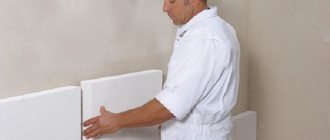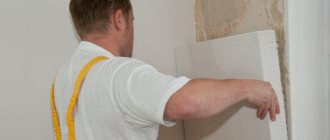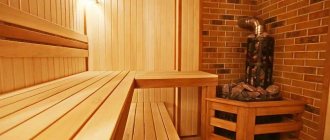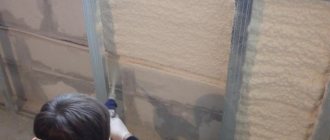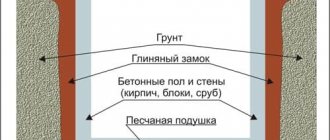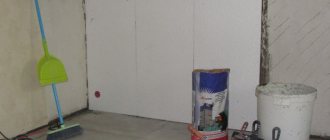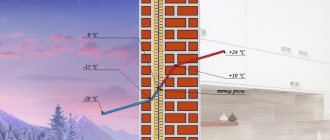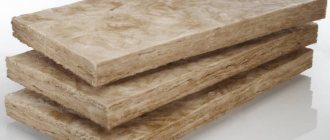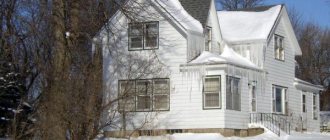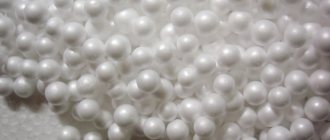A dacha is a place where you can relax from the noisy city and enjoy clean air. Although the dacha is not used for permanent residence, nevertheless, every owner wants it to be comfortable and cozy. It is better to think about the comfort of a dacha already at the stage of its construction. Or renovation work is being carried out.
The reasons for heat loss can be different. Heat usually escapes through surfaces that are poorly insulated. Consequently, not only the external part of the country house needs thermal insulation, but also the internal one. Therefore, in this article we will talk about insulating the internal walls of a country house. Which insulation to choose? How to directly insulate the inside of a house? Let's answer these questions.
Parameters when choosing a material
Before choosing one or another insulation material, you need to pay attention to the following parameters:
- Thermal conductivity level. The best option is a low level of thermal conductivity. Therefore, with a low thermal conductivity, the optimal temperature inside the room is maintained.
- Level of resistance to low temperatures. If the country house is not heated during the winter season, the temperature in it can drop below zero. This can lead to deformation of many types of insulation.
- Simplicity in the installation process. Owners of summer cottages usually want to arrange it themselves. Therefore, the heat insulator should be installed with your own hands without any problems.
- Price. Of course, quality is important, but still few people spend a lot of money on insulating a house for temporary residence.
These factors are fundamental when choosing insulation material.
When can you start insulating a building?
There is a basic rule in construction - it is necessary to begin finishing work on buildings after the house has completely settled. This may take about a year. Moreover, shrinkage occurs not only in wooden houses, but also in brick, monolithic frame buildings, etc.
Installation of thermal insulation is preferably carried out in dry weather - the house is well dried beforehand. The house should already have a roof, external waterproofing of the foundation, ventilation, windows, doors.
All work on finishing a log house begins only after it has settled
You should not start work either in frost or heat - you must wait until the temperature reaches above zero of 5-25°C. The optimal time to start finishing the facade is late spring or early autumn.
Making a greenhouse with your own hands from a profile pipe and polycarbonate: a complete description of the process, drawings with dimensions, watering and heating (Photo & Video)
Tips for choosing
Let's look at just two tips:
- The material from which your country house is built is the most important factor. You need to pay attention to it. For example, for houses built of wood, a thermal insulator is needed that has excellent air permeability. For houses built of brick, this criterion is not particularly important.
- The level of moisture resistance is also the most important parameter that you should pay attention to when choosing insulation for the internal walls of a country house. Ask yourself: will my home be heated during the winter season? This factor determines whether condensation will form due to the large temperature difference (indoors and outdoors). Condensation can cause the thermal insulation layer to become wet; it will deform in a short period and lose its technical characteristics.
But this problem can be easily eliminated if you use a specially designed vapor barrier film, which will protect the heat insulator from the harmful effects of moisture.
What building products exist for thermal insulation of walls from the inside?
Selection of thermal insulation material
Let's consider the most popular insulation products in detail.
Use of mineral wool
Mineral wool is an inorganic fiber made from porphyrite. This thermal insulation product can only be used under one condition. If the surface of the walls is additionally sheathed with plasterboard or wood, then the use of mineral wool is permitted.
This insulation product is best suited for structures made of wood or frame. Let's look at the main pros and cons of mineral wool.
The main advantages of this heat insulator:
- Mineral wool has a high level of resistance to sudden temperature changes. In addition to thermal insulation characteristics, this material has excellent sound insulation properties.
- The next plus is elasticity. Thanks to the previous factor (resistance to sudden temperature changes), mineral wool does not change in shape and does not change its structure.
- Another advantage is durability.
- This product is not flammable. You don't have to worry about safety. Mineral wool is not subject to ignition.
- For installation you do not need to have any specific knowledge or skills.
There are also disadvantages:
- Mineral wool is brittle - this is one of the parameters that complicates the installation process.
- Hygroscopicity. This product perfectly absorbs moisture. Because of this, the technical characteristics of mineral wool will deteriorate.
- Price. Mineral wool costs quite a lot of money compared to other thermal insulation materials.
Mounting instructions:
- First, it is necessary to seal all cracks and surface defects. Apply polyurethane foam.
- Use nails or screws as fastening materials. Some people attach it with glue.
- The slabs are laid from bottom to top.
Application of ecowool
This material is the most environmentally friendly. Ecowool contains recycled cellulose. This product is applied by spraying.
Let's consider the advantages:
- Excellent breathability.
- Although ecowool, like mineral wool, perfectly absorbs moisture, it dries in a short period of time. At the same time, its thermal insulation properties do not change.
- Ecowool also contains specially designed additives that make the material resistant to fire.
The downside is that ecowool itself is quite expensive , but you still need to spend extra money on the equipment that is necessary to apply it to the surface. To carry out installation you must have certain knowledge and experience.
Ecowool is an excellent insulation material for walls inside walls in a country house.
Ecowool is installed using three methods:
- dry method;
- wet method;
- wet-adhesive.
The wet method is the most commonly used. This includes the use of an adhesive - lignin. Ecowool, which is already moistened, can stick to the surface of the walls without problems. This method is used for thermal insulation of walls made of brick. First you need to make a sheathing from wooden blocks. After which the insulation material is applied using specially designed equipment.
Might be interesting
Thermal insulation
Insulating the ceiling in a bathhouse - methods, materials, useful...
Thermal insulation
Tables of comparative characteristics of thermal insulation…
Thermal insulation
Why polyurethane foam insulation is the best...
Thermal insulation
Self-adhesive thermal insulation: how to choose and apply?
Use of expanded polystyrene
This product is very popular among dacha owners. Expanded polystyrene has an average cost in the construction market.
Expanded polystyrene has all the necessary advantages:
- excellent strength;
- moisture resistance;
- ease of installation.
This is all that is needed to insulate the walls from the inside of the house.
Disadvantages of polystyrene foam:
- low level of breathability;
- poor adhesion to the facing surface;
- Not exactly an environmentally friendly material.
Expanded polystyrene is great for country cottages.
First, before starting the installation procedure, it is necessary to prepare the surface. That is, you need to apply plaster. Then the walls need to be washed to remove dirt. Next, a primer is applied, which has deep penetration.
Installation begins with the application of glue. You will have ten minutes to lay the polystyrene foam board. Reduce the distance between slabs. If any gaps remain, they must be filled with parts of polystyrene foam. After installation of the slabs, the reinforcing mesh is laid. Fastening is done using plaster. The layer is five millimeters. After drying, you need to apply the final coat.
Application of foam plastic
Polystyrene foam is the cheapest insulation product on the construction market. Polystyrene foam has a high level of moisture resistance and a low level of thermal conductivity.
Main advantages:
- Polyfoam is not afraid of fungus, mold and rot.
- Due to its low weight, polystyrene foam can be installed without problems.
- Strength. The product can withstand compression and bending.
Minuses:
- The product may become deformed from impacts.
- Poor airtightness.
- Material may release toxins when ignited.
It is best to insulate walls that are built of brick with polystyrene foam. Foam is not used for wooden houses.
Installation is carried out like expanded polystyrene.
Insulation of a wooden floor in a country house
A significant portion of the internal heat of a room can escape through the floor, especially if there is a basement. Therefore, effective thermal insulation of a dacha will also require internal thermal insulation of this structural element.
- The most effective will be insulation with floor removal, which is carried out according to the following scheme:
- A plank beating is nailed to the floor joists, which will form a flat base surface. OSB boards will be the best alternative to regular wood.
- Then a layer of waterproofing material is laid, which can be used as ordinary polyethylene film.
- The next layer is formed from insulation. The best choice in this case would be porous materials that provide good natural ventilation.
- The final stage is the installation of the second plank, which will serve as a subfloor. In this case, there should be a distance of 5-10 mm between the edge of the roll and the wall, necessary for natural ventilation. Later it can be covered with a plinth.
When choosing heat-insulating materials for internal floor insulation, you need to choose those that can withstand heavy physical loads. In particular, it can be polyurethane foam, polystyrene foam and expanded clay.
Unlike walls, the floor is best insulated both from the outside and from the inside, so it is highly recommended to insulate the external base of the dacha.
Tips for installing a heat insulator
Let's look at three tips:
- When insulating the walls of a country house from the inside, you need to know that the inner layer of heat insulation will take up useful space. Therefore, it is best to insulate small country houses from the outside.
- During installation, it is also necessary to take care of creating a ventilation gap, which should be located between the heat insulator and the decorative finish. What is the purpose of the ventilation gap? It is necessary so that the thermal insulation cake of the walls can be ventilated and the condensation can evaporate better.
- When carrying out a vapor barrier, be sure to use a specially designed film, which will protect the heat insulator from getting wet and freezing. It will protect the heat insulator from losing its original technical characteristics.
This anti-condensation film can be used for vapor barrier and waterproofing not only walls, but roofs.
Course of action
So, how to properly insulate a wooden house from the outside:
We will treat the wall of the house with an antiseptic (be it a village house made of logs or a timber house). Take special care of the ends of the logs, as these are the first to begin to rot. Choose a dry and hot day for antiseptic treatment. After the treatment is completed, let the walls dry for 2 days. Using a regular stapler, attach a waterproofing film with vapor-permeable properties to the cleaned and treated walls. This film has a different surface on each side: glossy and porous. The first should be attached to the insulation, and the second to the wall. The joints of the film should overlap and should be securely secured with tape. Nail the sheathing made using bars onto the film. The bars must have a thickness equal to the thickness of the insulating material. The width of the sheathing step should be less than the width of the slab of material, by 4 centimeters. Thus, by laying it at random, you will ensure the strength of the structure. Now is the time to lay the insulation, doing it more tightly so that there is no heat loss from the wooden house. There are a lot of videos on the Internet about insulating a wooden house from the outside, but you can do it even if you have never seen this process. If the mat is too wide, trim it with a knife. It turned out too loose - you will have to add cladding in the form of a batten. Finally, secure the finished structure with anchor nails. Many people like this solution of insulating an old house with several layers of insulation. In this case, each subsequent layer should be positioned in such a way as to not have common seams. The joints of the lower layers should not be visible under the joints of the upper ones
It is very important to protect yourself with special gloves and a respirator when working with mineral and stone wool. Do not neglect this safety rule! The next stage of insulating the walls outside in a wooden house: another film is attached to the insulation - a hydro-windproof membrane, it is attached to brackets, and its protective side should face outward. The joints, as in the previous case, must be overlapped, and to fasten them together, everything must be well taped with masking tape. Next, it’s up to the ventilated frame; this gap is ensured using the same bars as in the case of the sheathing
They are screwed to the lower structure with self-tapping screws. As a result, there should be at least 5 cm between the insulation, covered with wind protection, and the decorative layer. If we are insulating completely uneven walls, then we additionally use perforated hangers, which make it possible to set the distance to the frame. If the finishing of a wooden wall is planned with metal siding or corrugated sheeting, then it is possible to use a plasterboard profile instead of a block. The final stage for external walls is external finishing. This can be vinyl siding, block house, metal profile or another type at your request. For each such cladding, the manufacturer indicates the process technology, which must be followed. Make sure that the insulation of your wooden house under the siding or other sheathing is done without gaps.
The joints, as in the previous case, must be overlapped, and to fasten them together, everything must be well taped with masking tape. Next, it’s up to the ventilated frame; this gap is ensured using the same bars as in the case of the sheathing. They are screwed to the lower structure with self-tapping screws. As a result, there should be at least 5 cm between the insulation, covered with wind protection, and the decorative layer. If we are insulating completely uneven walls, then we additionally use perforated hangers, which make it possible to set the distance to the frame. If the finishing of a wooden wall is planned with metal siding or corrugated sheeting, then it is possible to use a plasterboard profile instead of a block. The final stage for external walls is external finishing. This can be vinyl siding, block house, metal profile or another type at your request. For each such cladding, the manufacturer indicates the process technology, which must be followed. Make sure that the insulation of your wooden house under the siding or other sheathing is done without gaps.
For comprehensive insulation of a wooden structure, as additional protection, insulate the base and foundation of the house, the ceiling, and insulation of the interfloor ceiling will also be required. For thermal insulation of a wooden house from below, penoplex or polystyrene, polyurethane foam are used.
Now you know how to insulate the walls of your village house. Do you know what a modern ventilated façade is? Do you know how to insulate the rubble, if we are talking about the basement of the house?
Wall insulation process
Thermal insulation of walls is the most important work because they occupy the largest area, and the highest heat transfer comes from them.
Before installing the heat insulator, it is necessary to prepare the surface:
- It must be cleaned of dirt and dust.
- Then treat the walls from the inside; this can be done using specially designed mixtures and aerosols. Thanks to this treatment, you can protect the wooden surface from pests. An excellent aerosol is Raptor for bedbugs (a professional product). This product is intended for removing bedbugs. The substance has a quick effect. The aerosol begins to act after a quarter of an hour. After using the aerosol, the room must be ventilated. You can also use dichlorvos instead of “bedbug raptor”.
- Next you need to caulk all the cracks using dry tow.
Jute fabric is excellent as a heat insulator for the walls of a country house.
Its installation is easy; this is done using a construction stapler . It must be placed on a beam and secured using this construction tool. After the walls are erected, the canvas will be compacted.
Jute fabric does not rot. Moths “do not attack” this insulation material. Jute fabric has a low level of thermal conductivity due to the fact that it has a structure in the form of capillaries. This material is absolutely environmentally friendly. Mold or mildew will not form on it.
For the process of insulating the walls of a country house, it is better not to use products such as wool, batting, and so on. Because these improvised products perfectly absorb moisture, which has a detrimental effect on heat retention. After a certain period of time, the material will become rotten. Wool also attracts moths.
Problems
This method has a number of disadvantages. It is for this reason that the method has many opponents. Insulating walls from the inside can cause the following problems:
- The walls are not protected from the cold. The supporting structure of the building continues to be in contact with the outside air. This can lead to its gradual destruction. Cracks will begin to appear on the surface. This measure not only does not protect the outer wall from the cold, but also takes away some of the heat from it, because before insulation, part of the heat from the room heated the wall, but now this flow is blocked.
- Condensation. It forms on a cold surface upon contact with warm air. Heating engineers call the place where condensation forms the dew point. The main task of thermal insulation is to move the dew point outside the wall. Insulation “from the inside” ensures that the dew point shifts to the boundary between the wall and the insulation. This process is hidden, so home owners do not notice it. But humidity will be an excellent condition for the proliferation of various microorganisms.
- Reducing the area of premises. Modern types of insulation have good efficiency. But science has not yet come up with such a good material that its thickness is minimal. To insulate a house from the room side, you will need 5 to 10 cm of insulation. This eats up the area quite a lot. This is not so noticeable to the eye, but if you calculate the losses for the entire building, the figure turns out to be significant.
With internal insulation, the dew point shifts to the boundary between the wall and the insulation.
Therefore, before deciding on internal insulation of the walls of the house, we recommend that you carefully think about the listed problems. In this case, ignorance does not exempt from responsibility, since the result of inattention will make itself felt in the first years of operation.
Bottom line
Let's summarize. When choosing a particular insulation material, it is necessary to take into account its technical characteristics, such as the level of thermal conductivity, ease of installation, and level of resistance to sudden temperature changes.
You need to pay attention not only to the technical characteristics of the thermal insulation product; the material from which the house is built plays a vital role. For many, cost is not the last parameter to which you should pay attention.
If you choose a high-quality heat insulator, and the installation is carried out in compliance with all the rules, you will be able to achieve unique comfort and coziness in your country house.
